Novel multi-drug-resistant yeast efficiently removed ammonia nitrogen from antibiotic-contaminated aquaculture water
IF 4.1
2区 环境科学与生态学
Q2 BIOTECHNOLOGY & APPLIED MICROBIOLOGY
International Biodeterioration & Biodegradation
Pub Date : 2025-05-03
DOI:10.1016/j.ibiod.2025.106111
引用次数: 0
Abstract
Aquaculture waters often contain antibiotics, which inhibit the removal of ammonia nitrogen (NH4+-N) by traditional microbial technologies. Thus, it is necessary to find potential microorganisms that can simultaneously tolerate to antibiotics and remove NH4+-N. This study applied a novel isolated multi-drug-resistant yeast strain named Naganishia diffluens Mo to remove NH4+-N in antibiotic-contaminated water. It was found the optimal conditions (glucose as carbon source, pH 7.0, 25 °C, 2 % inoculation, C/N ratio of 10) based on single-factor experiments for Naganishia diffluens Mo removing NH4+-N could achieve 91.6 %. Response surface methodology further opitimized this condition as C/N ratio of 15, 24.9 °C, and pH 6.9, achieving 94.8 % of NH4+-N removal, demonstrating great potentail to remove NH4+-N. Whole-genome analysis indicated that Naganishia diffluens Mo likely removes NH4+-N through ammonia assimilation, utilizing the GDH pathway and the GS-GOGAT metabolic pathway to incorporate NH4+-N into biomass without converting it to nitrate (NO3−) and nitrite (NO2−). Besides, Naganishia diffluens Mo contains multiple antibiotic-resistance genes and genes reponsible for NO3− and NO2− removal, suggesting its great potential for N removal in antibiotic-contaminated wastewater.
新型多重耐药酵母菌能有效去除受抗生素污染的水产养殖水体中的氨氮
养殖水体中通常含有抗生素,这抑制了传统微生物技术对氨氮(NH4+-N)的去除。因此,有必要寻找能够同时耐受抗生素和去除NH4+-N的潜在微生物。本研究利用新分离的多药耐药酵母菌Naganishia diffluens Mo去除抗生素污染水中的NH4+-N。通过单因素试验发现,以葡萄糖为碳源,pH 7.0, 25°C,接种量2%,C/N比为10的条件下,长岛扩散菌Mo对NH4+-N的去除率为91.6%。响应面法进一步优化该条件为C/N比为15、24.9℃、pH为6.9时,NH4+-N去除率为94.8%,显示了去除NH4+-N的巨大潜力。全基因组分析表明,naganishi diffluens Mo可能通过氨同化去除NH4+-N,利用GDH途径和GS-GOGAT代谢途径将NH4+-N转化为生物质,而不将其转化为硝酸盐(NO3−)和亚硝酸盐(NO2−)。此外,naganishi diffluens Mo含有多种抗生素抗性基因和负责NO3 -和NO2 -去除的基因,表明其在抗生素污染废水中的N去除潜力巨大。
本文章由计算机程序翻译,如有差异,请以英文原文为准。
求助全文
约1分钟内获得全文
求助全文
来源期刊
CiteScore
9.60
自引率
10.40%
发文量
107
审稿时长
21 days
期刊介绍:
International Biodeterioration and Biodegradation publishes original research papers and reviews on the biological causes of deterioration or degradation.

 求助内容:
求助内容: 应助结果提醒方式:
应助结果提醒方式:


